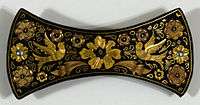Damascening
Damascening is the art of inlaying different metals into one another—typically, gold or silver into a darkly oxidized steel background—to produce intricate patterns similar to niello. The English term comes from a perceived resemblance to the rich tapestry patterns of damask silk.
Background
The technique has a long history in Japan, where it was used to decorate katana fittings, particularly tsuba. Known as zougan(象嵌) in Japanese, it has developed its own subset of terms to describe the particular patterns, although "shippou-zougan" is an enamelling technique which most Westerners would consider closer to champlevé.
Damascened-inlay jewelry, especially of Japanese origin, is sometimes referred to as shakudo from the use of that alloy as the dark background.
The technique of niello is also famously attested in prehistoric Greece. The earliest occurrence of damascening in the Aegean, from the Shaft Graves of Mycenae, dates to the latest Middle Bronze Age/Middle Helladic IIIB period (dagger Nu-304). Ultimately of Near Eastern provenance, the technique of inlaying silver/gold was adapted to suit Aegean taste and style.
Cities that are known for a rich history in Damascening where the technique is still practiced are Malaysia, Indonesia, Toledo, Spain, Eibar, Basque Country and Kyoto, Japan.
Toledo, Spain
Toledo has long been the major European centre, although most modern production is machine made, sometimes on tin rather than steel. Nevertheless, the art has long been practised in Persia, Japan and even China.
Some of these reproductions are "so expertly produced that even knowledgeable Toledeans admit the difficulty of recognizing them as such."[1] However, many shops still offer handcrafted damascened work following the tradition of ancient times, and it is possible to see artisans at work creating these painstaking and time-consuming works of art.
Damascene work has kept to traditional designs with few changes over the years, but there are a few artists who design innovative pieces of jewelry, which are sold in some of the shops of the city (not in all). Nowadays you can find also craftsmen who create high quality pieces, commissioned by private customers or collectors.
See also
References
- ↑ "DAMASCENE WARE IN SPAIN'S TOLEDO". The New York Times. 1982-04-11. ISSN 0362-4331. Retrieved 2016-06-20.
External links
- Ding bronze vessel with gold and silver inlay (Damascening) from the Warring States period (403-221 BC) of ancient China. (c. 300 BC)
 Detail of damascening, in this case gold inlaid into oxidized steel, in a hairclasp from Toledo, Spain.
Detail of damascening, in this case gold inlaid into oxidized steel, in a hairclasp from Toledo, Spain.
| Wikimedia Commons has media related to Damascening. |